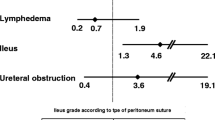Abstract
Aim
To investigate prognostic factors and complications after radical hysterectomy followed by postoperative radiotherapy for carcinoma of the uterine cervix.
Patients and Methods
One hundred twenty-eight patients with Tlb-2b carcinoma of the uterine cervix following radical hysterectomy with bilateral pelvic lymphadenectomy and postoperative radiation therapy were reviewed. Pathologic and treatment variables were assessed by multivariate analysis for local recurrence, distant metastases and cause specific survival.
Results
The number of positive nodes (PN) in the pelvis was the strongest predictor of pelvic recurrence and distant metastases. These 2 failure patterns independently affect the cause specific survival. The 5-year cumulative local and distant failure were PN(0): 2% and 12%, PN(1–2): 23% and 25%, PN(2<): 32% and 57%, respectively (p=0.0029 and p=0.0051). The 5-year cause specific survival rates were PN(0): 90%, PN(1–2): 59% and PN(2<): 42% (p=0.0001). The most common complication was lymphedema of the foot experienced by one-half of the patients (5-year: 42%, 10-year: 49%).
Conclusion
These results suggest that patients with pathologic Tlb-T2b cervix cancer with pelvic lymph node metastases are at high risk of recurrence or metastases after radical hysterectomy with pelvic lymphadenectomy and postoperative irradiation.
Zusammenfassung
Ziel
Untersuchung der prognostischen Faktoren und Komplikationen der adjuvanten Radiotherapie nach radikaler Hysterektomie bei Patienten mit Zervixkarzinom.
Patienten und Methoden
In dieser Studie wurden 128 Patientinnen mit Zervixkarzinom untersucht, bei denen die pathologische Untersuchung nach radikaler Hysterektomie mit gleichzeitiger bilateraler pelvischer Lymphadenektomie und postoperativer Radiotherapie die Klassifikation als Tlb-T2b-Karzinome ergab. Dabei wurden pathologische und therapeutische Parameter auf der behandelten Seite mit Hilfe der Multivarianzanalyse auf lokale Rezidive und Fernmetastasen beeinflussende Faktoren hin untersucht.
Ergebnisse
Die Zahl der metastatischen pelvischen Lymphknoten (PN) war der wichtigste Indikator fur die Wahrscheinlichkeit für das Auftreten von lokalen Rezidiven und Fernmetastasen, wobei beide Parameter die Überlebensrate der Grundkrankheit fast unabhängig voneinander beeinflußten. Die kumulativen Fünf-Jahres-Raten für lokale Rezidive und Fernmetastasen waren jeweils bei PN(0): 2% und 12%, PN(1–2): 23% und 25% und PN(2<): 32% und 57% (p=0,0029 und p=0,0051). Die Fünf-Jahres-Überlebensraten für die Grundkrankheit waren jeweils bei PN(0): 90%, PN(1–2): 59%, PN(2<): 42% (p=0,0001). Die häufigste Komplikation waren Lymphödeme der Füße, die bei etwa der Hälfte der Patienten auftraten (fünf Jahre: 42%, zehn Jahre: 49%).
Schlußfolgerung en
Diese Ergebnisse deuten darauf hin, daß bei Patientinnen mit pathologisch als Tlb-T2b klassifizierten Zervixkarzinomen mit Lymphknotenmetastasen ein hohes Risiko von Rezidiven oder Metastasen nach radikaler Hysterektomie mit pelvischer Lymphadenektomie und postoperativer Bestrahlung besteht.
Similar content being viewed by others
References
Atkovar G, Uzel O, Ozsahin M, et al. Postoperative radiotherapy in carcinoma of the cervix: treatment results and prognostic factors. Radiother Oncol 1995;35:198–205.
Beck-Bornholdt HP, Dubben HH. Potential pitfalls in the use of p-values and in interpretation of significance levels. Radiother Oncol 1994;33:171–6.
Berman ML, Bergen S, Salazar H. Influence of histological features and treatment on the prognosis of patients with cervical cancer metastatic to pelvic lymph nodes. Gynecol Oncol 1990;39:127–31.
Bianchi UA, Sartori E, Pecorelli S, et al. Treatment of primary invasive carvical cancer: Considerations on 997 consecutive cases. Eur J Gynecol 1988;9:47–53.
Chatani M, Matayoshi Y, Masaki M, et al. Prophylactic irradiation of para-aortic lymph nodes in carcinoma of the uterine cervix. Strahlenther Onkol 1995;171:655–60.
Cox DR. Regression model and life tables. J R Statist Soc 1972;34:187–220.
Gerbaulet AL, Konkler H, Kerr GR, et al. Combined radiotherapy and surgery, local control and complications in early carcinoma of the uterine cervix: the Villejuif experience, 1975–1984. Radiother Oncol 1992;23:66–73.
Gonsalez DG, Ketting BW, van Bunningen B, et al. Carcinoma of the uterine cervix stage IB and IIA: Results of postoperative irradiation in patients with microscopic infiltration in the parametrium and/or lymph node metastasis. Int J Radiat Oncol Biol Phys 1989;16:389–95.
Haie C, Pejovic MH, Gerbaulet A, et al. Is prophylactic para-aortic irradiation worthwhile in the treatment of advanced cervical carcinoma? Results of a controlled clinical trial of the EORTC radiotherapy group. Radiother Oncol 1988;11:101–12.
Killackey MA, Boardman L, Carroil DS. Adjuvant chemotherapy and radiation in patients with poor prognostic stage Ib/IIa carvical cancer. Gynecol Oncol 1993;49:377–9.
Kinney WK, Alvarez RD, Reid GC, et al. Value of adjuvant whole-pelvis irradiation after Wertheim hysterectomy for early-stage squamous carcinoma of the cervix with pelvic nodal metastasis: A matched control study. Gynecol Oncol 1989;34:258–62.
Kaplan EL, Meier P. Non-parametric estimations from incomplete observations. J Am Stat Assoc 1953;53:457–80.
Martimbeau PW, Kjorstad KE, Kolstad P. Stage IB carcinoma of the cervix, the Norwegian Radium Hospital, 1968–1970: Results of treatment and major complications. I. Lymphodema. Am J Obstet Gynecol 1978; 131:389–94.
Morrow CP. Is pelvic radiation beneficial in the postoperative management of Stage IB squamous cell carcinoma of the cervix with pelvic node metastasis treated by radical hysterectomy and pelvic lymphadenectomy? Gynecol Oncol 1980;10:105–10.
Perez CA, Kurman RJ, Stehman FB, et al. Uterine cervix. In: Hoskins WJ, Perez CA, Young RC, eds. Principles and practice of gynecologic oncology. Philadelphia: Lippincott, 1992:591–662.
Peto R, Pike MC, Armitage P, et al. Design and analysis of randomized clinical trials requiring prolonged observation of each patient: Analysis and examples. Br J Cancer 1977;35:1–39.
Rotman M, Choi K, Guze G, et al. Prophylactic irradiation of the paraaortic lymph node chain in stage IIB and bulky stage IB carcinoma of the cervix, initial treatment results of RTOG 7 920. Int J Radiat Oncol Biol Phys 1990;19:513–21.
Stock RG, Chen ASJ, Flickinger JC, et al. Node-positive cervical impact of pelvic irradiation and patterns of failure. Int J Radiat Oncol Biol Phys 1995;31:31–6.
Takamura A, Mizoe J, Arimoto T, et al. Is postoperative radiotherapy beneficial in the management of Stage I–II squamous cell carcinoma of the uterine cervix with negative metastatic nodes and positive parametrial involvement? A retrospective review of 70 patients. Asia-Oceania J Obstet Gycecol 1993;19:145–51.
Author information
Authors and Affiliations
Corresponding author
Rights and permissions
About this article
Cite this article
Chatani, M., Nose, T., Masaki, N. et al. Adjuvant radiotherapy after radical hysterectomy of the cervical cancer. Strahlenther Onkol 174, 504–509 (1998). https://doi.org/10.1007/BF03038982
Received:
Accepted:
Published:
Issue Date:
DOI: https://doi.org/10.1007/BF03038982




